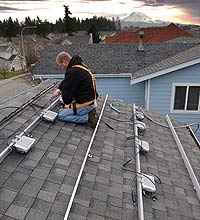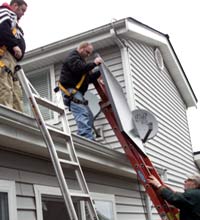About the author: Cara Peck is an Environmental Scientist in EPA Region 9. For the past three years she has worked on the recycling of organic materials, but is now working on reducing the climate change and energy implications from the Agriculture Industry.
I love food. At various points along the day, it is a safe bet that I’m thinking about what to eat for my next meal. This could be the product of growing up in Northern California where we have amazing food, or it could be because I love to cook and eating logically follows cooking. Whatever the reason, I’m a huge fan of food.
While many share my love of the culinary world, there is an ugly and harmful side to the delicacies we enjoy- food waste. Organic waste, which includes food, currently makes up 25% of what is going to landfills. In addition to a host of other problems, landfills emit methane, a potent greenhouse gas. In an effort to try to get this food waste out of landfills, I started researching the anaerobic digestion of food waste. Basically, in an atmosphere without oxygen, bacteria feed on the food waste, break it down, and produce biogas in the process. Amazingly, biogas is an energy source, so in the process of reducing waste, energy is produced!
To further explore this project, I managed a few projects that investigated using this technology at wastewater treatment facilities. Many wastewater treatment facilities already use anaerobic digesters to break down sewage sludge. In addition, most of these digesters have excess capacity for something like… food waste!
Here’s a snapshot of how the process works: food scraps are collected at nearby restaurants. Then are sent to a local wastewater treatment facility, processed and injected into the anaerobic digesters. The bacteria go to work, break down the waste and produce biogas. The biogas is captured and used on site to power the facility, or even sent back to the grid. The residual that is left after the bugs have done their job is reduced, making it much easier to truck to the compost facility. Upon further composting, the material can be used as a soil amendment to grow more food. It’s a true closed-loop, sustainable system.
This technology has national applicability and I’m excited to see it more widely adopted in an effort to reduce waste and to combat climate change.
Since I do love food so much, I must admit that there isn’t often much waste left on my plate. However, I feel a little better about my love affair with food knowing that the waste that is left is going to a higher use and not contributing to climate change.
 Keeping cool in hot weather usually takes energy - turning up the air conditioner, driving to a swimming spot, and more. But using more energy can affect the environment, too. Share how you keep from losing your cool.
Keeping cool in hot weather usually takes energy - turning up the air conditioner, driving to a swimming spot, and more. But using more energy can affect the environment, too. Share how you keep from losing your cool.
 Each week we write about the science behind environmental protection.
Each week we write about the science behind environmental protection.  Living and working in the heart of the corn belt, I am continually confronted with the promotion of corn ethanol as the green solution to gasoline. As a researcher in
Living and working in the heart of the corn belt, I am continually confronted with the promotion of corn ethanol as the green solution to gasoline. As a researcher in 


